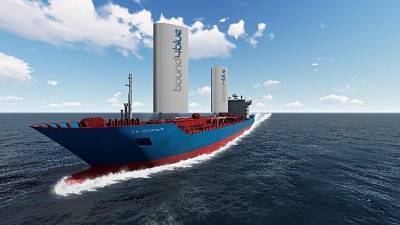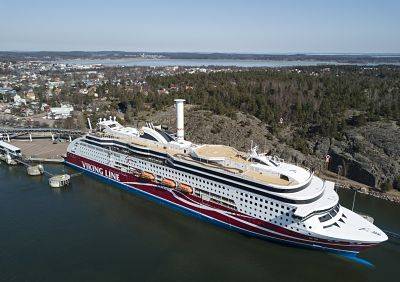Blowin’ in the Wind: Five Misconceptions of Wind Propulsion on Ships
In examining the history of commercial ships, the common refrain is “from sail to steam to diesel.” If the International Windship Association (IWSA) is right, that common refrain one day could be “from sail to steam to diesel … to sail.”
As the collective maritime industry struggles to find a future proof propulsion system to meet ever stricter environmental emissions mandates from the IMO, serious talk and research is being paid to alternative technologies such as wind propulsion. As shipowners warily eye 2050 and the recent mandate to reduce Greenhouse gas emissions by 50% by that date, it is commonly agreed that the technology to do so does not exist today.
According to the IWSA there has been a significant trend developing around wind propulsion technologies over the last 12 months, driven by big numbers surrounding potential fuel savings: 10 to 30% fuel savings for retrofit installations and up to 50% in fuel savings for optimized new builds. And the discussion and trials are not simpy the remit of the laboratory, as several large, leading shipowners are putting the tech to the test on the high seas.
Norsepower’s Rotorsails having recently been fitted to the Viking Grace and two 30m rotors on the 109,000dwt Maersk MV Pelican LR2 tanker. Peace Boat’s Ecoship design, which will be the world’s most sustainable cruise vessel, uses rigid sails as wind-assist on its 55,000 ton, 2,000 passenger vessel which will be built over the next few years.
“The same misconceptions about commercial wind propulsion solutions keep coming around, many of these are rooted in old appraisals of technologies used decades ago or on perceptions of stepping backwards,” said Gavin Allwright, Secretary General, IWSA. “However the wave of technologies and projects coming through now are firmly focused on a modern, decarbonized fleet fit for purpose in the 21st century.”
Allwright and IWSA contend that these are the five leading misconceptions about wind propulsion on modern ships.
 Image courtesy IWSA1.Wind Propulsion is an Old Technology: While it is true that the harnessing of wind for vessels is millennia old, the technologies that are being developed now have built on that wealth of knowledge, updated the systems, introduced new materials and automated the operations. “Our Rotor Sails are a modernized version of the Flettner rotor, which was invented almost 100 years ago,” said Jarkko Väinämö, CTO, Norsepower. “We have implemented high-tech materials and state-of-the-art automation technology for developing a reliable, efficient and economically feasible Rotor Sail design.”
Image courtesy IWSA1.Wind Propulsion is an Old Technology: While it is true that the harnessing of wind for vessels is millennia old, the technologies that are being developed now have built on that wealth of knowledge, updated the systems, introduced new materials and automated the operations. “Our Rotor Sails are a modernized version of the Flettner rotor, which was invented almost 100 years ago,” said Jarkko Väinämö, CTO, Norsepower. “We have implemented high-tech materials and state-of-the-art automation technology for developing a reliable, efficient and economically feasible Rotor Sail design.”
2.The New Rigs and Rotors are Untried & Untested: MARIN is a global leader in ship design testing, and Rogier Eggers, senior project manager said, “MARIN has already built a firm understanding of the performance of wind (assisted) ship propulsion and is continuing to broaden and refine its prediction methods. With this background we can assist to verify and improve performance together with operators, owners, yards, designers and wind propulsion suppliers.”
3.It’s only Suitable for Small Ships: “This is a common refrain and wholly inaccurate, yes wind propulsion systems work very well on smaller vessels and there should be much more development in the fishing, general cargo, small ferry sectors, however there are wind propulsion solutions for all sizes and types of vessels, and in part that is the reason that different systems are being developed, as one size doesn’t fit all,” said IWSA Allwright.
 This is not a small ship! Image courtesy IWSA4.These Systems Need More Crew, More Training: Some of the smaller, more traditional sailing rigs do need more sailing knowledge and crew, however most of the commercial wind propulsion systems are automated, turnkey solutions that are optimized through weather analysis, routing and other operational parameters.
This is not a small ship! Image courtesy IWSA4.These Systems Need More Crew, More Training: Some of the smaller, more traditional sailing rigs do need more sailing knowledge and crew, however most of the commercial wind propulsion systems are automated, turnkey solutions that are optimized through weather analysis, routing and other operational parameters.
5.Wind Propulsion is Costly, with High CAPEX and Long ROI’s: Installing a wind propulsion system is not inherently costly, and the costs of manufacture and installation will come down as more rigs are installed. With an increasing choice of technologies, from lighter, easily installed rotors to larger more substantial rigs, there are variable costs and returns. Fuel prices are again on the rise making these systems more attractive, and the beyond compliance and future proofing of vessels is also a key advantage.














